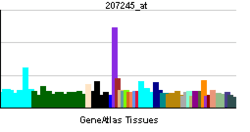UGT2B17
UDP-glucuronosyltransferase 2B17 is an enzyme that in humans is encoded by the UGT2B17 gene.[3][4]
UGT2B17 belongs to the family of UDP-glucuronosyltransferases (UGTs; EC 2.4.1.17), enzymes that catalyze the transfer of glucuronic acid from uridine diphosphoglucuronic acid to a variety of substrates, including steroid hormones.[supplied by OMIM][4]
References
Further reading
- Chung LW, Coffey DS (1978). "Androgen glucuronide. II. DIfferences in its formation by human normal and benign hyperplastic prostates.". Investigative urology. 15 (5): 385–8. PMID 76619.
- Moghissi E, Ablan F, Horton R (1984). "Origin of plasma androstanediol glucuronide in men.". J. Clin. Endocrinol. Metab. 59 (3): 417–21. doi:10.1210/jcem-59-3-417. PMID 6746859.
- Beaulieu M, Lévesque E, Tchernof A, et al. (1997). "Chromosomal localization, structure, and regulation of the UGT2B17 gene, encoding a C19 steroid metabolizing enzyme.". DNA Cell Biol. 16 (10): 1143–54. doi:10.1089/dna.1997.16.1143. PMID 9364925.
- Collier AC, Ganley NA, Tingle MD, et al. (2002). "UDP-glucuronosyltransferase activity, expression and cellular localization in human placenta at term.". Biochem. Pharmacol. 63 (3): 409–19. doi:10.1016/S0006-2952(01)00890-5. PMID 11853692.
- Chouinard S, Pelletier G, Bélanger A, Barbier O (2005). "Cellular specific expression of the androgen-conjugating enzymes UGT2B15 and UGT2B17 in the human prostate epithelium.". Endocr. Res. 30 (4): 717–25. doi:10.1081/ERC-200044014. PMID 15666817.
- Lazarus P, Zheng Y, Aaron Runkle E, et al. (2006). "Genotype-phenotype correlation between the polymorphic UGT2B17 gene deletion and NNAL glucuronidation activities in human liver microsomes.". Pharmacogenet. Genomics. 15 (11): 769–78. doi:10.1097/01.fpc.0000175596.52443.ef. PMID 16220109.
- Jakobsson J, Ekström L, Inotsume N, et al. (2006). "Large differences in testosterone excretion in Korean and Swedish men are strongly associated with a UDP-glucuronosyl transferase 2B17 polymorphism.". J. Clin. Endocrinol. Metab. 91 (2): 687–93. doi:10.1210/jc.2005-1643. PMID 16332934.
- Park J, Chen L, Ratnashinge L, et al. (2006). "Deletion polymorphism of UDP-glucuronosyltransferase 2B17 and risk of prostate cancer in African American and Caucasian men.". Cancer Epidemiol. Biomarkers Prev. 15 (8): 1473–8. doi:10.1158/1055-9965.EPI-06-0141. PMID 16896035.
- Gallagher CJ, Muscat JE, Hicks AN, et al. (2007). "The UDP-glucuronosyltransferase 2B17 gene deletion polymorphism: sex-specific association with urinary 4-(methylnitrosamino)-1-(3-pyridyl)-1-butanol glucuronidation phenotype and risk for lung cancer.". Cancer Epidemiol. Biomarkers Prev. 16 (4): 823–8. doi:10.1158/1055-9965.EPI-06-0823. PMID 17416778.
- Park JY, Tanner JP, Sellers TA, et al. (2007). "Association between polymorphisms in HSD3B1 and UGT2B17 and prostate cancer risk.". Urology. 70 (2): 374–9. doi:10.1016/j.urology.2007.03.001. PMID 17826523.
- Chouinard S, Barbier O, Bélanger A (2008). "UDP-glucuronosyltransferase 2B15 (UGT2B15) and UGT2B17 enzymes are major determinants of the androgen response in prostate cancer LNCaP cells.". J. Biol. Chem. 282 (46): 33466–74. doi:10.1074/jbc.M703370200. PMID 17848572.
